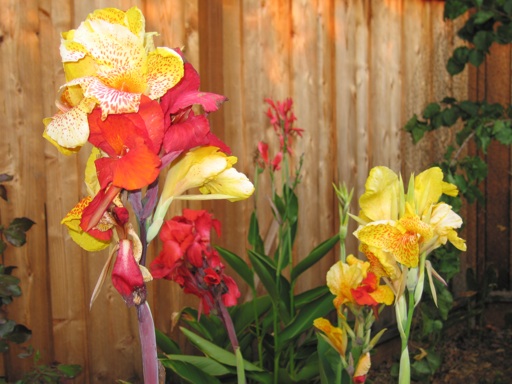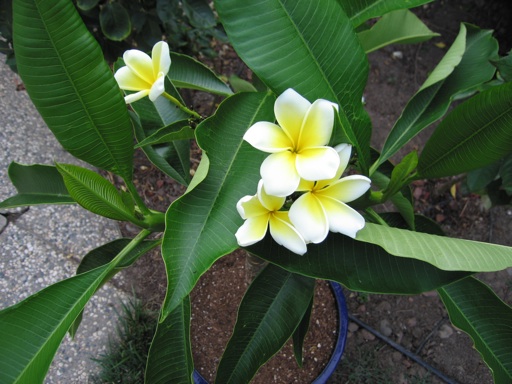
I have always been fond of cannas. I am partial to their colorful and asymmetrical flowers as well as their large, tropical-looking leaves. When I first started growing cannas, I couldn’t get them to bloom. I later realized that they weren’t blooming, because I wasn’t watering them enough.
I live in a region that only gets about 15″-20″ of rain per year, and most of that rains falls from November through March. It hasn’t rained at our house this year since late February. When I water them at least every few days, cannas grow rapidly and bloom in a few months, even though I never fertilize them. As soon as they dry out, they stop growing. They seem to not like having their roots dry out during the growing season.
Because cannas like to be moist, they tend to attract snails. Snails eat the leaves while the cannas are growing, leaving an unattractive pattern of holes in the leaves. I haven’t been able to find an effective control for the snail problem. Putting copper tape around the base of each steam is not really practical, especially because the stems need to be cut to the ground as soon as they finish blooming. I don’t like to use liquid snail poison or pellets, because they wash away quickly after a watering. I have been hand picking the snails off the leaves.
I am not sure what these cannas are called. A friend gave them to us.
July 19 2008 | Cannas | Comments Off on Canna Display

This is a picture of a plumeria plant I have growing in a pot. It just started blooming for the first time a few weeks ago, and the fragrance of the flowers is incredible. Plumeria flowers are used to make leis in Hawaii. Plumeria, common name Frangipani, is a tropical plant that is native to Central America. I am stunned that we have managed to get it to bloom here in northern California.
I bought it at a grocery store 3 years ago. It was about 7″ tall when I bought it. It’s now about 2-2.5 feet tall. After transplanting it into a larger pot about 2 years ago, my partner fertilized it regularly with fish emulsion, an organic fertilizer. Since then, it has grown substantially.
Every winter, we take the pot indoors in November when the low temperatures start to fall below 40 degrees. It’s a deciduous plumeria. So it loses its leaves every winter and becomes dormant. The label didn’t indicate what species of plumeria it is, but I’m guessing that it’s P. alba.
Last fall, the plant started forming buds, but the weather began to turn cold before they opened. All of the leaves eventually fell off. But the buds stayed on. About half of the buds turned brown and shriveled up during dormancy. The remaining buds have been opening now that the plant is growing again. This plant seems to thrive in the warm sunny days of summer in direct sunlight. And it does not seem to mind being indoors in the winter in a spot where it gets only indirect sunlight. I think deciduous plumeria could be grown in a pot in any climate that has a long, warm growing season.
July 19 2008 | Plumeria | Comments Off on Plumeria in a Pot

